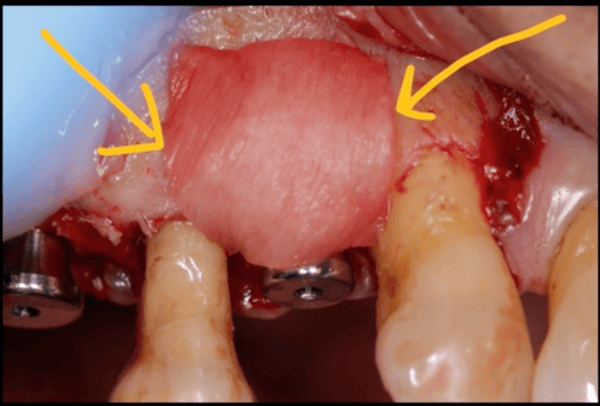There so many different kinds of resorbable membranes it is difficult to know which membrane to choose. The answer, of course, is that it depends on the clinical situation. Certain membranes are simply better options for specific procedures. A good example is buccal contour augmentation.
In this short video, Dr. Gober demonstrates the benefits of using the OsseoSeal collagen membrane for buccal contour augmentation. OsseoSeal is a resorbable collagen membrane derived from purified porcine pericardium. What makes the OsseoSeal membrane an excellent choice for buccal contour augmentation is the membranes excellent flexibility, which allows you to easily adapt the membrane to the area you are trying to regenerate.
In the case demonstrated here, the patient was missing multiple teeth in the upper right posterior. The treatment plan was to place an implant in site #3 and site #5. As illustrated, the patient had a deficient buccal contour. After placement of the implants, it was clear from the occlusal view that bone regeneration would be necessary.
Buccal contour augmentation simultaneous with implant placement is well documented in the literature. Allograft particulate is placed over the buccal plate. Then the OsseoSeal membrane is trimmed and draped over the bone graft, and onto the adjacent bony margins. The video shows how well OsseoSeal adapted to the surrounding bony margins, and you could only achieve this adaptability with a flexible membrane like OsseoSeal. A stiffer collagen membrane, on the other hand, would just sit there and there would be a gap in between the margin of the membrane and the bone. So a flexible membrane, like OsseoSeal, is perfect for this type of situation because it will conveniently adapt to the defect.

timcarter comments:
Just for clarification and perhaps to generate a productive discussion I would like to know why you chose to use a membrane at all given that the procedure was purely for contour?
drdangober comments:
Can you explain the rationale of your question? I'm not sure I understand what your premise is.
timcarter comments:
My understanding and the way I have practiced for the past 15 years is that a contour graft is just that and is not intended to be a regenerative procedure. Since it is purely for the purpose of creating anatomical contour there is no need to utilize a cell occlusive membrane. While there is nothing wrong with using one I think it is often misunderstood what the purpose of a particular procedure is. For example, while I prefer FDBA for my regenerative procedures I like a slower resorbing xenograft for my contour graft and I opt to not cover my contour graft with a membrane while I do cover my regenerative procedures. Obviously I am describing different methods to skin the same cat. I think it is important that the membrane be understood and while critical for regeneration it is not so for contour. Nice case...
raman comments:
I may be wrong but I believe the intention of the graft was as much about contour augmentation as it was about new bone. Probably new bone is the more important in this case as the bone to the buccal of the implant appeared to be less than 1mm in thickness. Whatever the actual thickness was it was certainly less than the ideal of 2-3mm. As such a membrane would be indicated.
timcarter comments:
Why would "new bone" be required when the fixture is completely in bone with no exposure. IMHO this is purely a contour graft and while there is absolutely nothing wrong with incorporating a membrane it is not necessary and by all means a patient should not be charged an additional fee for an unnecessary step. I think in dentistry, and particularly in implant dentistry, we tend to do a lot of procedures just because we feel better about it rather than having any evidence to support it.
timcarter comments:
If the concept of new radiographic bone formation without the use of a cell occlusive membrane is hard to visualize then I would suggest looking at the PAO/SFOT/Wilko studies where they form a lot of new facial bone contour without the use of any membrane. I started doing Wilko back in 2009 and seeing the bone formation via CBCT forever changed my view on membranes for contour and tissue support.
Very nicely done, great result.
TY for your kind comment. Do you do procedures like this in your practice?
Yes I do usually 5-10 of these types of cases a month
